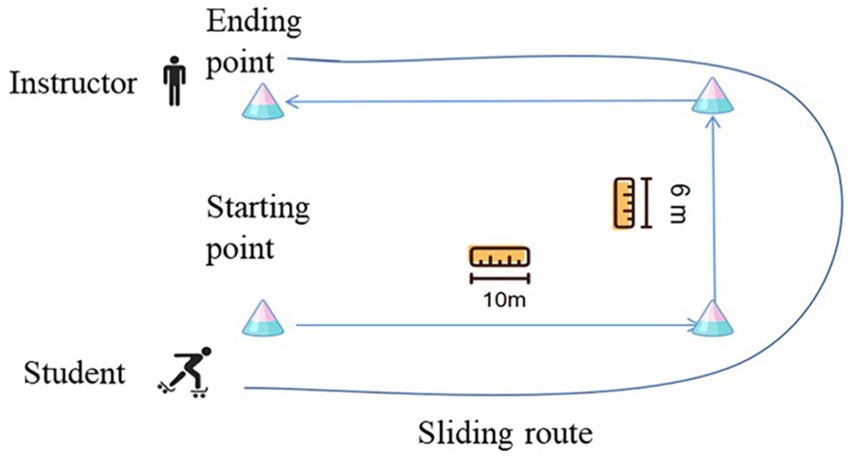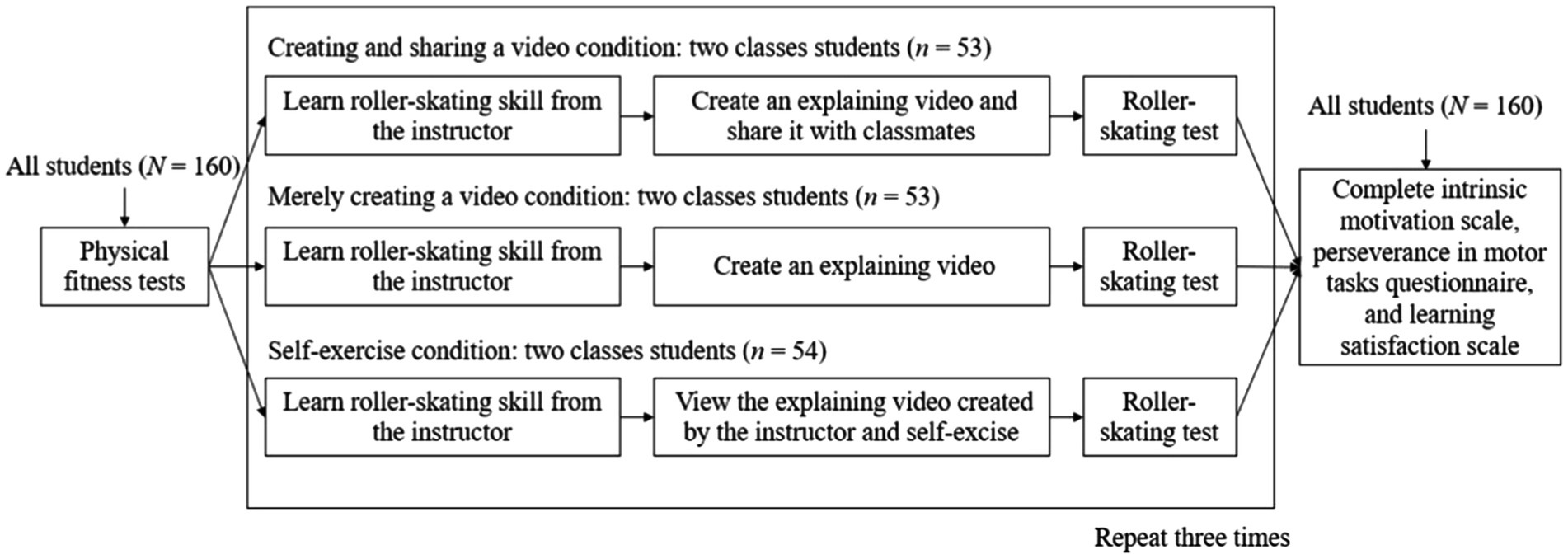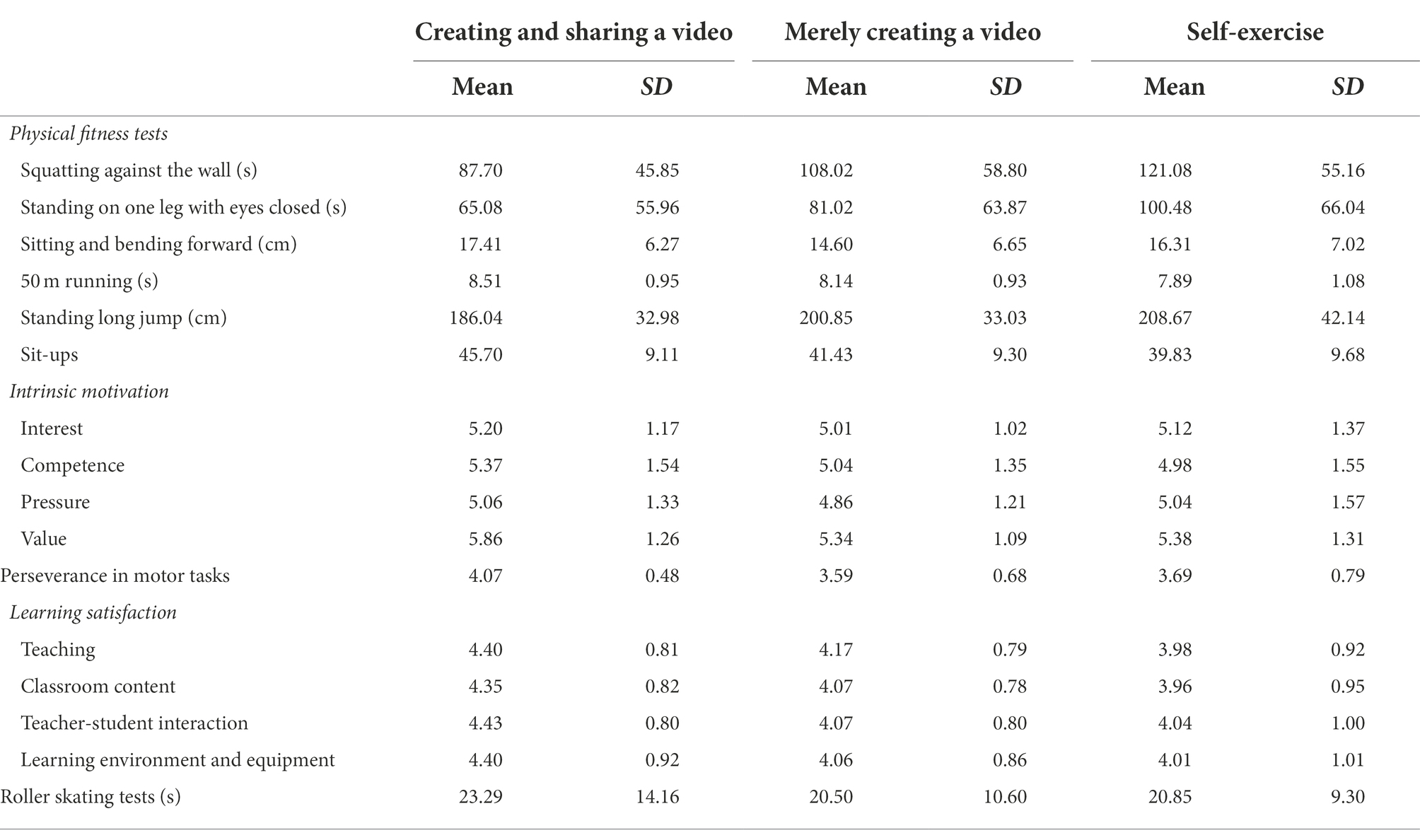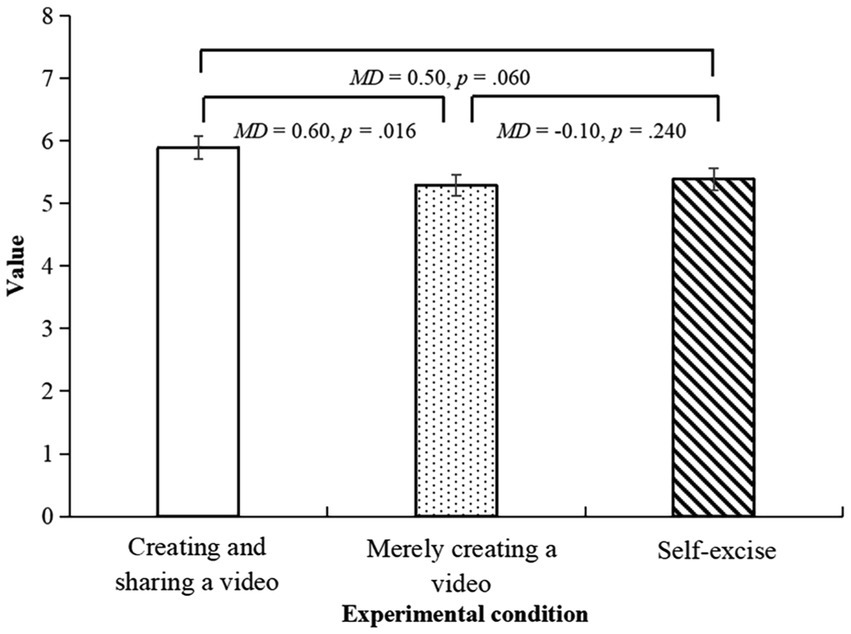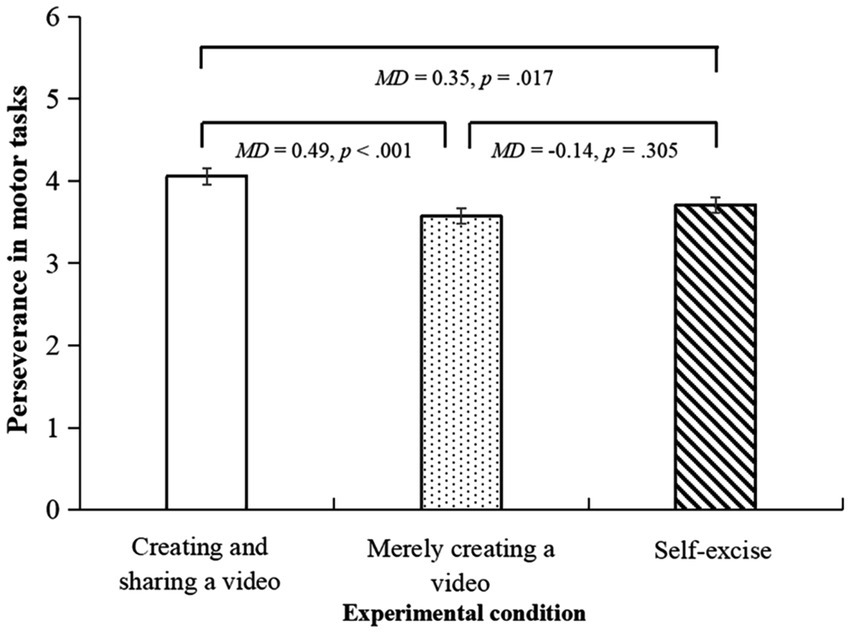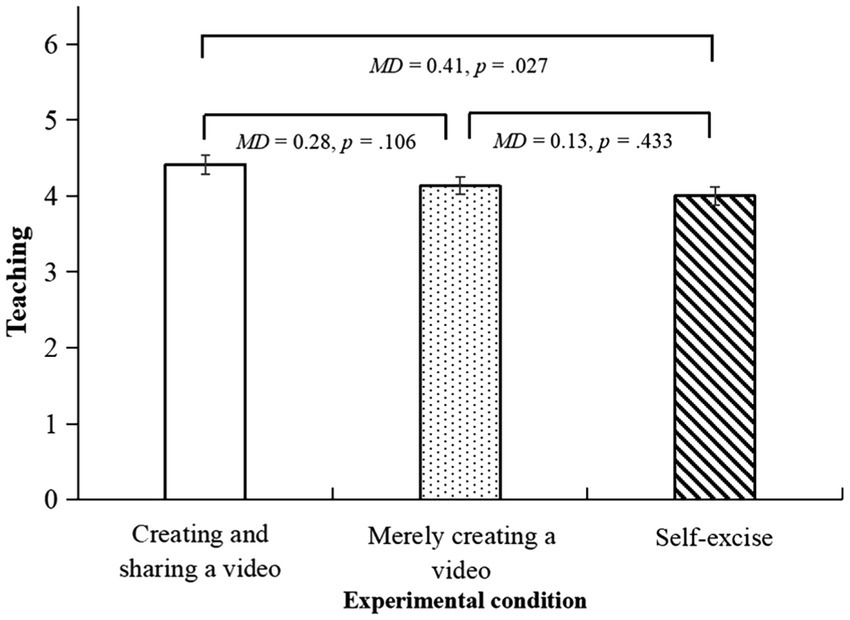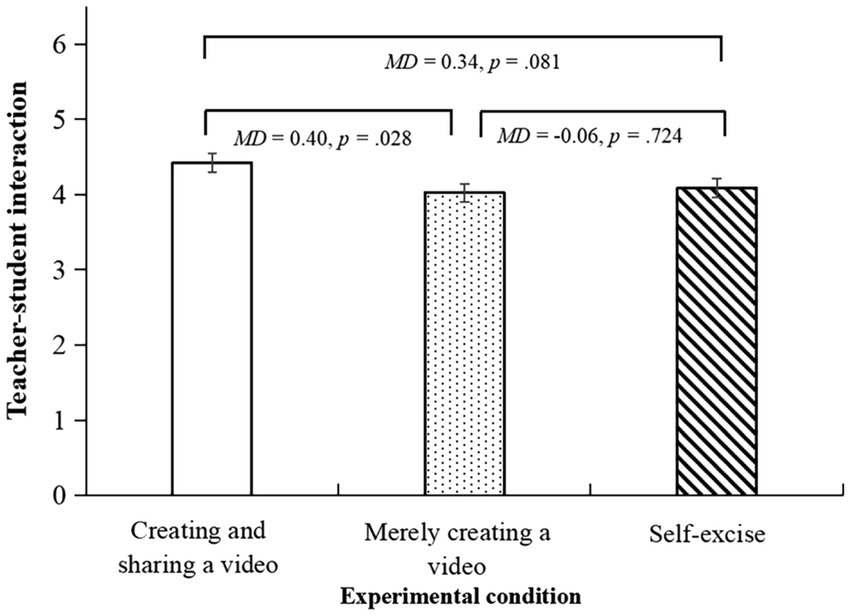- 1Department of Physical Education, Zhejiang Gongshang University, Hangzhou, China
- 2Ministry of Public Foundation, Zhejiang College of Shanghai University of Finance and Economics, Jinhua, China
Parallel to the tremendous growth and expansion of video technology, it is easy and enjoyable for students to create a video as a learning activity. However, most previous studies primarily focused on declarative knowledge learning (e.g., language learning, science learning) rather than motor skill learning. The current study aimed to investigate whether creating and sharing a video with classmates would be more effective than merely creating a video and self-exercise to learn a motor skill in terms of intrinsic motivation, perseverance in learning, learning satisfaction, and roller-skating skill. Partially consistent with our hypothesis, we found that creating and sharing a video with classmates increased students’ intrinsic motivation, perseverance in motor tasks, and learning satisfaction, but not roller-skating skill, followed by merely creating a video and then self-exercise. The findings have an important implication for motor skills learning: during teaching motor skills, teachers can use encourage students to create and share a video with classmates as a homework activity to increase students’ intrinsic motivation, perseverance in motor tasks, and learning satisfaction.
Introduction
Technology has developed significantly, and its impacts are inevitable on education in multiple disciplines (e.g., language learning, science learning, motor skills; Aguilar and Pifarre Turmo, 2019; Chang et al., 2020; Zainuddin and Che’ Lah, 2022). As the nature of dynamic and multichannel presenting learning content, learning from a video is immensely popular and an essential ingredient of many contemporary instructional approaches, such as massive open online courses, flipped classrooms, and even traditional classrooms (Noetel et al., 2021; Rekik et al., 2021). However, previous studies primarily consider videos to deliver learning content to students (Pi et al., 2021, 2022).
Parallel to the tremendous growth and expansion of video technology, it is easy and enjoyable for students to create a video as a learning activity (Greene and Crespi, 2012; Hoogerheide et al., 2019). Some emerging studies are interested in the effects of creating videos by students (Sari et al., 2020; Zainuddin and Che’ Lah, 2022). Creating a video offers students a chance to exercise and self-assessment. During creating a video, students can develop their interpretation, capture, review, and evaluate their performance on their own or by seeking their peers’ views (Huang, 2015; Zainuddin and Che’ Lah, 2022).
Recent research on learning strategies has shown that creating a video can be an effective strategy for learning (Hoogerheide et al., 2019; Erlangga, 2021; Zainuddin and Che’ Lah, 2022). For example, the study by Zainuddin and Che’ Lah (2022) tested the effects of video creation in English classrooms. They found that video creation increased students’ confidence and eventually improved their speaking skills. Similar results were obtained by Hoogerheide et al. (2019) with different learning content (i.e., biology). Again, students creating a video consistently experienced more enjoyment, which may stimulate engagement factors such as perseverance in learning, and showed higher learning satisfaction and better learning performance compared to restudy (Garland, 1982). Perseverance in learning refers to persistence at a learning task, which is evidenced to can be promoted by task enjoyment (Leonard and Weitz, 1971). The benefits of video creation have since been replicated in other studies (Huang, 2015; Sari et al., 2020; Erlangga, 2021; Jung, 2021).
However, most previous studies primarily focused on declarative knowledge learning (e.g., language learning, science learning) rather than motor skill learning. There are some differences between declarative knowledge and motor skill learning (Anderson, 1982). Specifically, declarative knowledge is ‘know-what’ knowledge (e.g., facts, concepts, and theory); motor skill is ‘know-how’ knowledge (e.g., roller-skating, playing ping-pong, and swimming). Therefore, motor skill learning includes learning declarative knowledge and mastering how to enact the skill via exercise (van Abswoude et al., 2019). Physical educators struggle with the challenges of creating opportunities for all students to engage in exercise and self-assessment daily, such as roller-skating (Finkenberg et al., 2005). Creating a video as a learning activity can address these challenges by encouraging students to show motor skills, develop their interpretation, capture, review, and evaluate their performance on their own (Huang, 2015; Zainuddin and Che’ Lah, 2022).
Researchers have proposed several potential mechanisms for the effects of creating video. First, the exercise effect postulates that exercise has beneficiary effects on motor skill consolidation (Chen et al., 2019; Khan et al., 2022). Exercise helps students acquire motor memory, which is stored in the form of cortical spine plasticity (Yang et al., 2009; Hayashi-Takagi et al., 2015). During creating a video to show the learned motor skill, students engage in exercise that is effective for motor skill learning (Chen et al., 2019; Khan et al., 2022).
Second, the self-assessment effect builds on empirical studies and suggests that creating a video enables students to self-assess related to their learning and performance by viewing a created video (Paul et al., 1998; Huang, 2015; Ritchie, 2016; Zainuddin and Che’ Lah, 2022). Consequently, self-assessment enhances their self-reflection and adjustment. Some studies have shown that creating video raise students’ awareness of self-assessment by viewing a created video and improves learning performance in the oral presentation (Ritchie, 2016; Tailab and Marsh, 2020).
Third, the social facilitation effect in motor tasks argues that the mere presence of others increases students’ arousal level, intrinsic motivation, and elicits the perception of evaluation by others, and thus influences their performance in motor tasks (Cottrell, 1968; Strauss, 2002). Intrinsic motivation is an essential component of learning, which refers to motivation that originates from within students and consists of spontaneous interest and mastery (Ryan and Deci, 2000). It is a common phenomenon for students to create videos and share them with their classmates later (Huang, 2015, 2021). Therefore, students are aware of the potential audience (i.e., peers) while creating videos. Research has shown that merely believing that someone else is watching you (i.e., a fictitious audience) can evoke arousal (Somerville et al., 2013; Hoogerheide et al., 2018). Based on empirical studies on the social facilitation hypothesis in motor tasks, the mere presence of others facilitates motor skills that have been formulated (Zajonc, 1965; Strauss, 2002).
Although accumulative studies confirmed the benefits of creating a video on students’ intrinsic motivation, engagement, and learning performance (Huang, 2015; Hoogerheide et al., 2018; Erlangga, 2021), it is yet unclear whether creating a video is an effective strategy in motor skills and which working mechanism is responsible for such effects. Specifically, it is unclear whether the benefits of creating a video result from engaging in exercise, self-assessment, or others presence.
The present study tested whether creating and sharing a video with classmates or not would improve students’ motor skill learning (i.e., roller-skating) compared to the self-exercise condition. To control time on task, students created videos or did self-exercise in a physical class. Merely creating a video and self-exercise were used as control conditions, which also encourages exercise and self-assessment by viewing the created video but lacks others presence. Furthermore, compared to creating and sharing a video with classmates, self-exercise lacks self-assessment and others presence. We examined effects on intrinsic motivation, perseverance in motor tasks, learning satisfaction, and roller-skating skill. Based on previous studies and theories, we proposed the following hypotheses.
H1: Students who create and share a video with classmates will show higher intrinsic motivation, followed by those who merely create a video and, finally, those who do self-exercise.
H2: Students who create and share a video with classmates will show higher perseverance in motor tasks, followed by those who merely create a video and, finally, those who do self-exercise.
H3: Students who create and share a video with classmates will show better motor skills, followed by those who merely create a video and, finally, those who do self-exercise.
Materials and methods
Participants and design
A total of 160 students (79 females and 81 males, mean age = 20.08, SD = 1.28, Range: 18–22 years) from six classes in one Chinese university participated in the study. None of their majors are physics or physics related. We adopted a between-subjects design and thus randomly assigned two classes of students one of three conditions to learn roller-skating. In the creating and sharing a video with classmates condition, there were 53 students (27 females and 26 males, mean age = 20.04 years, SD = 1.26, range: 18–22); In the merely creating a video condition, there were 53 students (27 females and 26 males, mean age = 20.32 years, SD = 1.33, range: 19–22); In the self-exercise condition, there were 54 students (25 females and 29 males, mean age = 19.87 years, SD = 1.23, range: 18–22). All the students were informed of the learning tasks and volunteered to participate in the study.
Martials
Physical fitness tests
Physical fitness tests included squatting against the wall, standing on one leg with eyes closed, sitting and bending forward, 50 m running, standing long jump, and sit-ups. Each test is related to roller skating learning. Specifically, squatting against the wall tests the basic strength of the legs; standing on one leg with eyes closed tests the balance, sitting and bending forward tests the flexibility of the body; 50 m running tests the displacement speed of the body; standing long jump tests the lower limb explosive force; and sit-ups test the waist strength and core control ability. These tests are from the National Student Physical Health Standards in China (Zhang, 2019).
Intrinsic motivation scale
The intrinsic motivation scale was developed by Lin et al. (2020). The scale contains 12 items and includes four dimensions: interest (e.g., “I find this learning activity very interesting”), competence (e.g., “I think I am good at this learning activity”), pressure (e.g., “I’m not nervous at all when doing this study activity”), and value (e.g., “I think this class is very useful to me”). Participants indicated their endorsement of each item on a 7-point scale (e.g., 1 = strongly disagree, 7 = strongly agree). High scores indicated high levels of learning motivation. The Cronbach’s alpha coefficients for the four dimensions in the current study were.54, 0.94, 0.94, and.74, respectively.
Perseverance in motor tasks questionnaire
The perseverance in motor tasks questionnaire was adapted from Zhou (1991). The questionnaire measures the degree of students’ persistence when encountering learning difficulties, learning disabilities, or external stimuli in motor skills learning. It includes 14 items, such as “When you find a problem that you could not solve in the past during practice, you will try to solve it again within two or 3 days.” The participants answered each item based on their actual situation using a five-point Likert scale (1 = completely inconsistent; 5 = completely consistent). The higher the score, the higher the persistence of the participants. The Cronbach’s alpha coefficient of the questionnaire in the current study was 0.91.
Learning satisfaction scale
The learning satisfaction scale was adapted from Wang (2014). The scale contains 17 items and four dimensions: Teaching, course content, teacher-student interaction, and learning environment and equipment. Teaching contains six items, such as “Teachers’ professional knowledge is very rich, and I have learned new knowledge and skills”; course content contains five items, such as “The task in learning is challenging”; teacher-student interaction contains three items, such as “Through mutual learning, I can fully participate in the learning process”; learning environment and equipment contains three items, such as “Satisfied with the normal operation of teaching.” The students needed to evaluate every item according to their feelings using a five-point Likert scale (1 = completely disagree; 5 = completely agree). The higher the score, the more satisfied students are with teaching. The Cronbach’s alpha coefficients for the four dimensions in the current study were 0.95, 0.96, 0.97, and 0.98, respectively.
Roller-skating test
Students completed a total of 26 m roller skating in a roller-skating test. The test included three parts. In part one, students slid forward 10 m from the starting point. In part two, students turned left and slid forward for 6 m. In part three, students turned left and slid forward for 10 m to get the ending point. An instructor at the ending point recorded time. The finish time of 26 m was the roller-skating achievement for students. Shorter the finish time, the better the roller-skating achievement. The test map can be seen in Figure 1.
Procedure
Figure 2 shows the procedure. First, participants completed physical fitness tests. After that, each class was randomly assigned to one experimental condition, and a male instructor taught the exact content of roller-skating, including standing and sliding. Participants did exercises following the instructor. Then, in the creating and sharing a video condition, the instructor asked the students to create an explaining video in a physical class and share it with their classmates in the WeChat group (i.e., a popular social media in China). In the merely creating a video condition, the instructor asked the students to create an explaining video in a physical class. In the self-exercise condition, students watched the explaining video created by the instructor rather than creating their videos and did exercises themselves in a physical class. At last, all students completed the roller-skating test. These steps were repeated three times. Finally, after the third class, all students finished the questionnaires.
Data analysis
We first tested whether there were differences in the physical fitness tests among the three conditions. We conducted between-group comparisons to test H1, H2 and H3: intrinsic motivation, perseverance in motor tasks, and performance on the roller-skating test. If there were differences in the physical fitness tests among the three conditions, to eliminate the potential influence of the participants’ physical fitness on the results, we conducted these comparisons with the analysis of covariance (ANCOVA), in which we used the scores on the physical fitness tests as covariates in our models. All analyses were carried out on SPSS 26.
Result
Table 1 shows the means and standard deviations (SD) of all variables in the current study.
Physical fitness tests
We first tested the differences in physical fitness tests among the three conditions. The results of one-way ANOVAs showed significant differences in squatting against the wall, F(2,157) = 5.27, p = 0.006, ηp2 = 0.06. Post hoc comparison (LSD) showed that participants’ time in the creating and sharing a video condition was significantly shorter than those in the self-exercise condition (MD = −33.38, p = 0.002, 95% CI [−53.83, −12.92]).
There were significant differences in standing on one leg with eyes closed, F(2,157) = 4.36, p = 0.014, ηp2 = 0.05. Post hoc comparison showed that participants’ time in the creating and sharing a video condition was significantly shorter than those in the self-exercise condition (MD = −35.41, p = 0.004, 95% CI [−59.13, −11.68]).
There were marginally significant differences in sitting and bending forward, F(2,157) = 2.41, p = 0.094, ηp2 = 0.03. Post hoc comparison showed that participants’ distance in the creating and sharing a video condition was significantly longer than those in the merely creating a video condition (MD = 2.813, p = 0.032, 95% CI [0.26, 5.37]);
There were significant differences in 50 m running, F(2,157) = 5.39, p = 0.005, ηp2 = 0.06. Post hoc comparison showed that participants’ time in the creating and sharing a video condition was significantly longer than those in the self-exercise condition (MD = 0.62, p = 0.001, 95% CI [0.25, 1.00]).
There were significant differences in standing long jump, F(2,157) = 5.34, p = 0.006, ηp2 = 0.06. Post hoc comparison showed that participants’ distance in the creating and sharing a video condition was significantly shorter than those in the merely creating a video condition (MD = −14.81, p = 0.038, 95% CI [−28.75, −0.86]), and was significantly shorter than those in the self-exercise condition (MD = −22.64, p = 0.002, 95% CI [−36.52, −8.75]);
There were significant differences in sit-ups, F(2,157) = 5.59, p = 0.004, ηp2 = 0.07, and post hoc comparison showed that participants’ number in the creating and sharing a video condition was significantly more than those in the merely creating a video condition (MD = 4.26, p = 0.020, 95% CI [0.67, 7.86]), and was significantly more than those in the self-exercise condition (MD = 5.87, p = 0.001, 95% CI [2.29, 9.44]).
In sum, the above results indicated that participants in the three conditions were different in physical fitness. Therefore, we conducted ANCOVAs to test the effects of creating video on motor skill learning, the scores on the physical fitness tests as covariates.
Intrinsic motivation
For the interest, competence, and pressure dimensions, there was no significant difference between the three conditions, F(2,151) = 0.59, p = 0.556, ηp2 = 0.01; F(2,151) = 0.63, p = 0.536, ηp2 = 0.01; F (2,151) = 0.50, p = 0.607, ηp2 = 0.01.
For the value dimension, there were significant differences between the three conditions, F(2,151) = 3.15, p = 0.046, ηp2 = 0.04. The post hoc tests showed that participants in the creating and sharing a video condition reported a significantly higher score than those in the merely creating a video condition (MD = 0.60, p = 0.016, 95% CI [0.11, 1.10]) and a higher score, in a marginally significant level, than those in the self-exercise condition (MD = 0.50, p = 0.060, 95% CI [−0.02, 1.03]). See Figure 3.
Perseverance in learning
The ANCOVA showed that there were significant differences in the score of the perseverance in motor tasks questionnaire between the three conditions, F(2,151) = 6.42, p = 0.002, ηp2 = 0.08. The post hoc tests showed that participants in the creating and sharing a video condition reported a significantly higher score than those in the merely creating a video condition (MD = 0.49, p < 0.001, 95% CI [0.22, 0.76]) and the self-exercise condition (MD = 0.35, p = 0.017, 95% CI [0.06, 0.64]). See Figure 4.
Learning satisfaction
For the teaching dimension, there were differences in a marginally significant level between the three conditions, F(2,151) = 2.60, p = 0.078, ηp2 = 0.03. The post hoc test showed that participants in the creating and sharing a video condition reported a significantly higher score than those in the self-exercise condition (MD = 0.41, p = 0.027, 95% CI [0.05, 0.77]). See Figure 5.
For the teacher-student interaction dimension, there were a difference in a marginally significant level between the three conditions, F (2,151) = 2.65, p = 0.074, ηp2 = 0.03. The post hoc test showed that participants in the creating and sharing a video condition reported a significantly higher score than those in the merely creating a video condition (MD = 0.40, p = 0.028, 95% CI [0.04, 0.75]), and a higher score, in a marginally significant level, than those in the self-exercise condition (MD = 0.34, p = 0.08, 95% CI [−0.04, 0.71]). See Figure 6.
For the course content and the learning environment and equipment dimensions, there was no significant difference between the three conditions, F(2,151) = 2.23, p = 0.111, ηp2 = 0.03; F(2,151) = 1.95, p = 0.146, ηp2 = 0.03.
Roller-skating test
We calculated the average time of three roller-skating tests as the final scores. The result showed no significant difference between the three conditions, F(2,151) = 0.68, p = 0.508, ηp2 = 0.01.
Discussion
The current study aimed to investigate whether creating and sharing a video with classmates would be more effective than merely creating a video and self-exercise to learn a motor skill in terms of intrinsic motivation, perseverance in learning, learning satisfaction, and roller-skating skill. Partially consistent with our hypothesis, we found that creating and sharing a video with classmates increased students’ intrinsic motivation, perseverance in motor tasks, and learning satisfaction, but not roller-skating skill, followed by merely creating a video and then self-exercise. The results broadened our understanding of the effects of creating a video on motor skills learning.
In line with our first and second hypotheses that creating a video improved intrinsic motivation and perseverance in motor tasks compared with self-exercise, we confirmed the benefits of creating a video on students’ intrinsic motivation (i.e., the value dimension) and perseverance in motor tasks compared to self-exercise. The results were consistent with previous studies, showing creating a video increases students’ intrinsic motivation (i.e., value) and learning satisfaction (Greene and Crespi, 2012; Yang and Wu, 2012; Huang, 2015; Zainuddin and Che’ Lah, 2022). Previous studies have shown that creating a video encourages students’ engagement and supports support authentic learning (Kearney and Schuck, 2003; Schuck and Kearney, 2004; Greene and Crespi, 2012). Some researchers defined behavioral engagement as effort and perseverance in learning (Lee, 2014). Furthermore, intrinsic motivation is positively associated with enhanced perseverance in learning (Larson and Rusk, 2011). Students may have been more inclined to persevere with the difficult material due to intrinsic motivation (Logan et al., 2011).
In contrast to our third hypothesis that creating and sharing a video with classmates facilitated roller-skating skills most, we did not observe differences in the roller-skating skills among the three conditions. The results suggested that self-exercise was enough to lead to good performance in the roller-skating test. Hoogerheide et al. (2019) found that creating videos did not outperform the summarizing condition, like the self-exercise condition in the present study. Additionally, the study by Sari et al. (2020) also did not observe students’ English skills/proficiency was improved by creating video sharing on YouTube. Therefore, exercise, self-assessment, or other presence seem to not contribute to the mechanisms underlying the benefits of creating video. In contrast, teaching expectancy might play an essential role in the benefits of creating videos observed in previous studies (Hoogerheide et al., 2018, 2019). The studies on teaching by creating videos have shown that students in the teaching on video condition consistently outperform and report more engagement (Hoogerheide et al., 2016, 2018, 2019; van Brussel et al., 2021). Future work should test whether a teaching expectancy enhances the benefits of creating a video on learning motor skills.
This study has the following limitations. First, this study did not test the long-term effect of creating and sharing a video with classmates. We observed that creating and sharing a video increased students’ intrinsic motivation and perseverance in motor tasks. Intrinsic motivation is a powerful “engine” of learning (Larson and Rusk, 2011). Intrinsic motivation is associated with enhanced engagement and perseverance in learning but with greater use of meta-cognitive strategies and deeper information processing (Larson and Rusk, 2011). Therefore, the benefits of creating and sharing a video with classmates might be exhibited over time. Future studies should test the long-term effect of creating and sharing a video with classmates. Second, we did not analyze the videos created by students. Previous studies on generative learning have shown that the quantity and quality of generative learning activities mediate the effect of generative learning strategies (e.g., self-explaining) on learning performance (Baars et al., 2018; Hefter, 2021; Bichler et al., 2022). Future research should further investigate the mediating role of the quantity and quality of the videos created by students.
Although there were some limitations, the present study advances our understanding of the various effects of two types of creating video compared to self-exercise. With the rapid development of video technology, it is easy for students to create a video as an enjoyable activity (Greene and Crespi, 2012; Hoogerheide et al., 2019). The present study tested the various effects of video creation by including three conditions: creating and sharing a video with classmates, merely creating a video, and self-exercise. Additionally, we measured students’ subjective perceptions and their objective performance on the roller-skating test. Our results suggest that video creation enhances students’ intrinsic motivation, perseverance in motor tasks, and learning satisfaction compared to self-exercise; sharing with classmates can further enhance their intrinsic motivation, perseverance in motor tasks, and learning satisfaction; self-exercise guarantees good performance on motor skill.
In conclusion, the main finding of the present study was that students who created and shared a video with classmates reported higher intrinsic motivation, perseverance in motor tasks, and learning satisfaction, but not the roller-skating skill, followed by those who merely creating a video and then those who self-exercise. With the easy availability of video production software, the findings have an important implication for motor skills learning: during teaching motor skills, teachers can use encourage students to create and share a video with classmates as a homework activity to increase students’ intrinsic motivation, perseverance in motor tasks, and learning satisfaction.
Data availability statement
The original contributions presented in the study are included in the article/supplementary material, further inquiries can be directed to the corresponding author.
Ethics statement
The studies involving human participants were reviewed and approved by the Ethics Committee of Zhejiang Gongshang University. The participants provided their written informed consent to participate in this study.
Author contributions
QX: conceptualization, methodology, writing – original draft, and writing-reviewing and editing. LK: investigation, data curation, visualization, and methodology. ZZ: supervision and conceptualization. All authors contributed to the article and approved the submitted version.
Conflict of interest
The authors declare that the research was conducted in the absence of any commercial or financial relationships that could be construed as a potential conflict of interest.
Publisher’s note
All claims expressed in this article are solely those of the authors and do not necessarily represent those of their affiliated organizations, or those of the publisher, the editors and the reviewers. Any product that may be evaluated in this article, or claim that may be made by its manufacturer, is not guaranteed or endorsed by the publisher.
References
Aguilar, D., and Pifarre Turmo, M. (2019). Promoting social creativity in science education with digital technology to overcome inequalities: a scoping review. Front. Psychol. 10:1474. doi: 10.3389/fpsyg.2019.01474
Anderson, J. R. (1982). Acquisition of cognitive skill. Psychol. Rev. 89, 369–406. doi: 10.1037/0033-295X.89.4.369
Baars, M., Leopold, C., and Paas, F. (2018). Self-explaining steps in problem-solving tasks to improve self-regulation in secondary education. J. Educ. Psychol. 110, 578–595. doi: 10.1037/edu0000223
Bichler, S., Stadler, M., Bühner, M., Greiff, S., and Fischer, F. (2022). Learning to solve ill-defined statistics problems: does self-explanation quality mediate the worked example effect? Instr. Sci. 50, 335–359. doi: 10.1007/s11251-022-09579-4
Chang, K.-E., Zhang, J., Huang, Y.-S., Liu, T.-C., and Sung, Y.-T. (2020). Applying augmented reality in physical education on motor skills learning. Interact. Learn. Environ. 28, 685–697. doi: 10.1080/10494820.2019.1636073
Chen, K., Zheng, Y., Wei, J., Ouyang, H., Huang, X., Zhang, F., et al. (2019). Exercise training improves motor skill learning via selective activation of mTOR. Science. Advances 5:eaaw1888. doi: 10.1126/sciadv.aaw1888
Cottrell, N. B. (1968). “Performance in the presence of other human beings: mere presence, audience, and affiliation effects,” in Social Facilitation and Imitative Behavior. eds. E. C. Simmel, R. A. Hoppe, and S. A. Milton (Boston, MA: Allyn and Bacon).
Erlangga, R. A. (2021). Students’ motivation in learning English through English learning videos making. Soc. Sci. Stud. 1, 177–189. doi: 10.47153/sss13.2542021
Finkenberg, M. E., Fiorentino, L. H., and Castelli, D. (2005). Creating a virtual gymnasium. J. Phys. Educat. Recreat. Dance 76, 16–18. doi: 10.1080/07303084.2005.10608231
Garland, H. (1982). Goal levels and task performance: a compelling replication of some compelling results. J. Appl. Psychol. 67, 245–248. doi: 10.1037/0021-9010.67.2.245
Greene, H., and Crespi, C. (2012). The value of student created videos in the college classroom – an exploratory study in marketing and accounting. Int. J. Arts Sci. 5, 273–283.
Hayashi-Takagi, A., Yagishita, S., Nakamura, M., Shirai, F., Wu, Y. I., Loshbaugh, A. L., et al. (2015). Labelling and optical erasure of synaptic memory traces in the motor cortex. Nature 525, 333–338. doi: 10.1038/nature15257
Hefter, M. H. (2021). Web-based training and the roles of self-explaining, mental effort, and smartphone usage. Technol. Knowl. Learn. doi: 10.1007/s10758-021-09563-w [Epub ahead of print]
Hoogerheide, V., Deijkers, L., Loyens, S. M. M., Heijltjes, A., and Van Gog, T. (2016). Gaining from explaining: learning improves from explaining to fictitious others on video, not from writing to them. Contemp. Educ. Psychol. 44–45, 95–106. doi: 10.1016/j.cedpsych.2016.02.005
Hoogerheide, V., Renkl, A., Fiorella, L., Paas, F., and Van Gog, T. (2018). Enhancing example–based learning: teaching on video increases arousal and improves problem–solving performance. J. Educ. Psychol. 111, 45–56. doi: 10.1037/edu0000272
Hoogerheide, V., Visee, J., Lachner, A., and Van Gog, T. (2019). Generating an instructional video as homework activity is both effective and enjoyable. Learn. Instr. 64:101226. doi: 10.1016/j.learninstruc.2019.101226
Huang, H. (2015). The effects of video projects on EFL learners’ language learning and motivation: an evaluative study. Int. J. Comput. Assist. Lang. 5, 53–70. doi: 10.4018/IJCALLT.2015010104
Huang, H.-W. (2021). Effects of smartphone-based collaborative vlog projects on EFL learners’ speaking performance and learning engagement. Australas. J. Educ. Technol. 37, 18–40. doi: 10.14742/ajet.6623
Jung, C. D. (2021). Perceptions of collaborative video projects in the language classroom: a qualitative case study. Int. J. Instr. 14, 301–320. doi: 10.29333/iji.2021.14418a
Kearney, M., and Schuck, S. (2003). “Authentic learning through the use of digital video.” in Proceedings of the Australian Computers in Education Conference. eds. W. Au and B. White. Adelaide, Australia.
Khan, A., Singh, J., Neary, J. P., and Mang, C. S. (2022). Exercise effects on motor skill consolidation and intermuscular coherence depend on practice schedule. Brain Sci. 12:436. doi: 10.3390/brainsci12040436
Larson, R. W., and Rusk, N. (2011). Intrinsic motivation and positive development. Adv. Child Dev. Behav. 41, 89–130. doi: 10.1016/B978-0-12-386492-5.00005-1
Lee, J. S. (2014). The relationship between student engagement and academic performance: is it a myth or reality? J. Educ. Res. 107, 177–185. doi: 10.1080/00220671.2013.807491
Leonard, S., and Weitz, J. (1971). Task enjoyment and task perseverance in relation to task success and self-esteem. J. Appl. Psychol. 55, 414–421. doi: 10.1037/h0031706
Lin, L., Ginns, P., Wang, T., and Zhang, P. (2020). Using a pedagogical agent to deliver conversational style instruction: what benefits can you obtain? Comput. Educ. 143:103658. doi: 10.1016/j.compedu.2019.103658
Logan, S., Medford, E., and Hughes, N. (2011). The importance of intrinsic motivation for high and low ability readers’ reading comprehension performance. Learn. Individ. Differ. 21, 124–128. doi: 10.1016/j.lindif.2010.09.011
Noetel, M., Griffith, S., Delaney, O., Sanders, T., Parker, P., del Pozo Cruz, B., et al. (2021). Video improves learning in higher education: a systematic review. Rev. Educ. Res. 91, 204–236. doi: 10.3102/0034654321990713
Paul, S., Dawson, K. P., Lanphear, J. H., and Cheema, M. Y. (1998). Video recording feedback: a feasible and effective approach to teaching history-taking and physical examination skills in undergraduate paediatric medicine. Med. Educ. 32, 332–336. doi: 10.1046/j.1365-2923.1998.00197.x
Pi, Z., Zhang, Y., Zhou, W., Xu, K., Chen, Y., Yang, J., et al. (2021). Learning by explaining to oneself and a peer enhances learners’ theta and alpha oscillations while watching video lectures. Br. J. Educ. Technol. 52, 659–679. doi: 10.1111/bjet.13048
Pi, Z., Zhu, F., Zhang, Y., Chen, L., and Yang, J. (2022). Complexity of visual learning material moderates the effects of instructor’s beat gestures and head nods in video lectures. Learn. Instr. 77:101520. doi: 10.1016/j.learninstruc.2021.101520
Rekik, G., Belkhir, Y., Mezghanni, N., Jarraya, M., Chen, Y. S., and Kuo, C.-D. (2021). Learning basketball tactical actions from video modeling and static pictures: when gender matters. Children 8:1060. doi: 10.3390/children8111060
Ritchie, S. M. (2016). Self-assessment of video-recorded presentations: does it improve skills? Act. Learn. High. Educ. 17, 207–221. doi: 10.1177/1469787416654807
Ryan, R. M., and Deci, E. L. (2000). Self-determination theory and the facilitation of intrinsic motivation, social development, and well-being. Am. Psychol. 55, 68–78. doi: 10.1037/0003-066X.55.1.68
Sari, A. B. P., Dardjito, H., and Azizah, D. M. (2020). EFL students’ improvement through the reflective you tube video project. Int. J. Instr. 13, 393–408. doi: 10.29333/iji.2020.13425a
Schuck, S., and Kearney, M. (2004). Students in the director’s seat: teaching and learning across the school curriculum with student-generated video (Research Report). Available at: http://epress.lib.uts.edu.au/research/bitstream/handle/10453/14209/SchuckKearney.04.pdf?sequence=1
Somerville, L. H., Jones, R. M., Ruberry, E. J., Dyke, J. P., Glover, G., and Casey, B. J. (2013). The medial prefrontal cortex and the emergence of self-conscious emotion in adolescence. Psychol. Sci. 24, 1554–1562. doi: 10.1177/0956797613475633
Strauss, B. (2002). Social facilitation in motor tasks: a review of research and theory. Psychol. Sport Exerc. 3, 237–256. doi: 10.1016/S1469-0292(01)00019-X
Tailab, M., and Marsh, N. (2020). Use of self-assessment of video recording to raise students’ awareness of development of their oral presentation skills. High. Educ. Stud. 10, 16–28. doi: 10.5539/hes.v10n1p16
van Abswoude, F., Van Der Kamp, J., and Steenbergen, B. (2019). The roles of declarative knowledge and working memory in explicit motor learning and practice among children with low motor abilities. Human Kinetics Journals 23, 34–51. doi: 10.1123/mc.2017-0060
van Brussel, S., Timmermans, M., Verkoeijen, P., and Paas, F. (2021). Teaching on video as an instructional strategy to reduce confirmation bias—a pre-registered study. Instr. Sci. 49, 475–496. doi: 10.1007/s11251-021-09547-4
Wang, X. (2014). Research on the Influence of Information Presentation and Self-Efficacy on Learning Effect. Liaoning: Liaoning normal university.
Yang, G., Pan, F., and Gan, W.-B. (2009). Stably maintained dendritic spines are associated with lifelong memories. Nature 462, 920–924. doi: 10.1038/nature08577
Yang, Y., and Wu, I. (2012). Digital storytelling for enhancing student academic achievement, critical thinking, and learning motivation: a year-long experimental study. Comput. Educ. 59, 339–352. doi: 10.1016/j.compedu.2011.12.012
Zainuddin, K., and Che’ Lah, C.-F. (2022). Students’ perceptions on the implementation of recorded oral presentation. J. Administr. Sci. 19, 233–246.
Zhang, Y. (2019). Physical literacy-oriented “National Student Physical Health Standards” (Primary stage) formulation analysis and implementation research. Unplished Doctoral Dissertation. Hunan Normal University.
Keywords: video creation, self-exercise, motor skill learning, intrinsic motivation, video learning
Citation: Xia Q, Ke L and Zheng Z (2022) Is video creation more effective than self-exercise in motor skill learning? Front. Psychol. 13:1032680. doi: 10.3389/fpsyg.2022.1032680
Edited by:
Zhongling Pi, Shaanxi Normal University, ChinaReviewed by:
Xiaoxian Liu, Henan Normal University, ChinaXin Zhao, The University of Sheffield, United Kingdom
Zhu Ke, Henan Normal University, China
Copyright © 2022 Xia, Ke and Zheng. This is an open-access article distributed under the terms of the Creative Commons Attribution License (CC BY). The use, distribution or reproduction in other forums is permitted, provided the original author(s) and the copyright owner(s) are credited and that the original publication in this journal is cited, in accordance with accepted academic practice. No use, distribution or reproduction is permitted which does not comply with these terms.
*Correspondence: Zheng Zheng, ejIwMTUxMDRAc2h1ZmUtemouZWR1LmNu
 Qiudong Xia
Qiudong Xia Lu’an Ke1
Lu’an Ke1